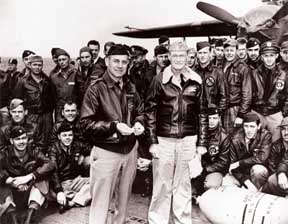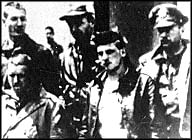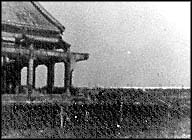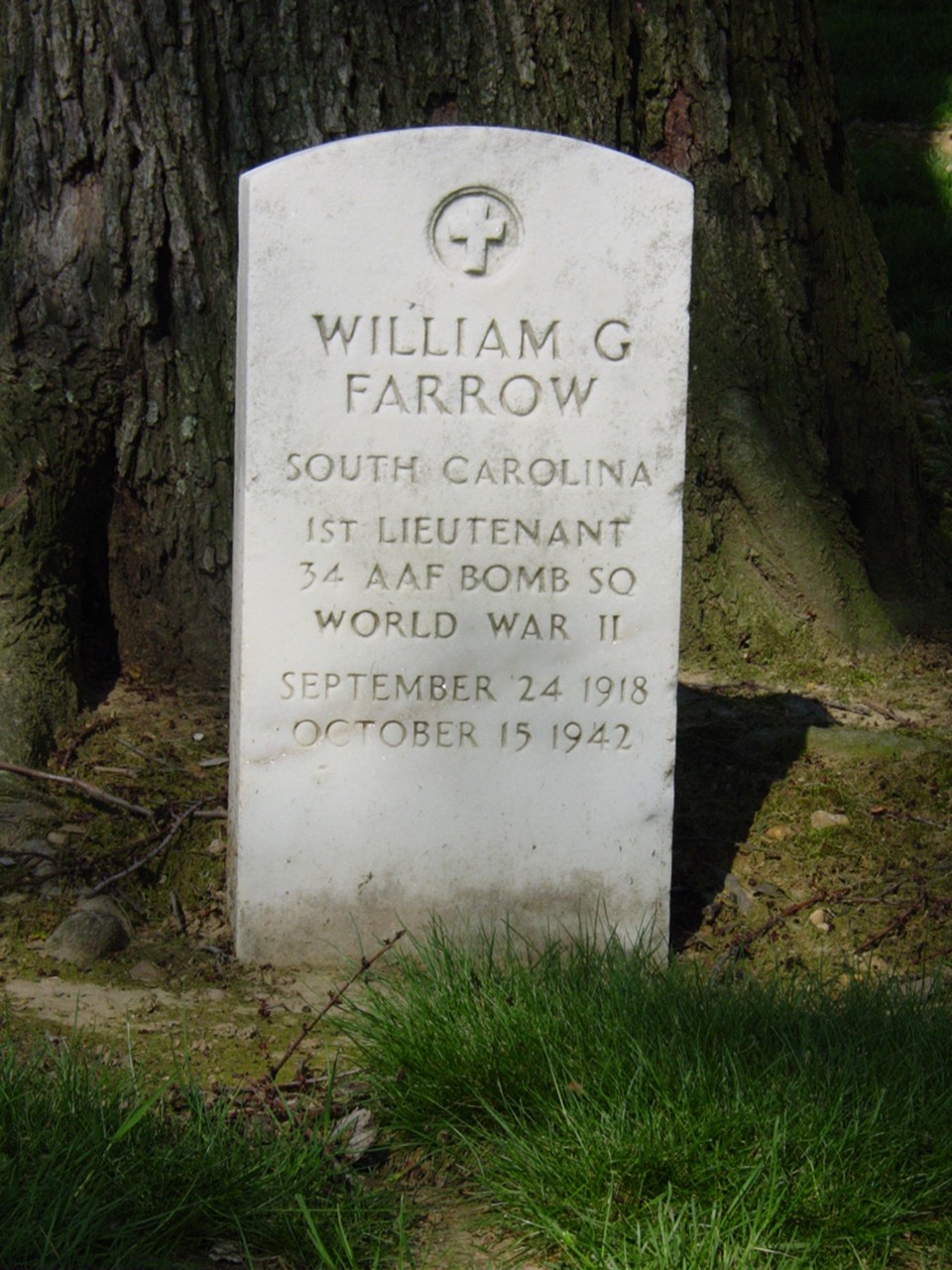“Don’t let this get you down. Just remember God will make everything right and that I’ll see you all again in the hereafter. . . . Read “Thanatopsis” by Bryant if you want to know how I am taking this. My faith in God is complete, so I am unafraid.”
— William G. Farrow
Doolittle pilot executed by the Japanese in World War II
from Excerpt from a letter to his mother.
A “Doolittle Raider,” he took off from the deck of the USS Hornet on April 18, 1942, successfully completed a bombing raid against the Japanese mainland and then crash-landed off the coast of China where he and his crew were captured by the Japanese.
After months of torture he was executed by the Japanese along with Dean E. Hallmark and Harold Spatz on October 15, 1942. His body was cremated by the Japanese and his ashes were located after the war and returned to the United States where they were buried in Section 12 of Arlington National Cemetery.
Following the Tokyo Raid, the crews of two planes were missing. On August 15, 1942. it was learned from the Swiss Consulate General in Shanghai that eight American flyers were prisoners of the Japanese at Police Headquarters in that city.
On October 19, 1942, the Japanese broadcast that they had tried two crews of the Tokyo Raid and had sentenced them to death, but that a larger number of them had received commutation of their sentences to life imprisonment and a lesser number had been executed. No names or facts were given.
After the war, the facts were uncovered in a War Crimes Trial held at Shanghai which opened in February 1946 to try four Japanese officers for mistreatment of the eight POWs of the Tokyo Raid. Two of the original ten men, Dieter and Fitzmaurice, had died when their B-25 ditched off the coast of China. The other eight, Hallmark, Meder, Nielsen, Farrow, Hite, Barr, Spatz, and DeShazer were captured. In addition to being tortured, they contracted dysentery and beri-beri as a result of the deplorable conditions under which they were confined.
On August 28, 1942, Hallmark, Farrow, and Spatz were given a “trial” by Japanese officers, although they were never told the charges against them. On October 14, 1942, Hallmark, Farrow, and Spatz were advised they were to be executed the next day. At 4:30 p.m. on October 15, 1942 the three Americans were brought by truck to Public Cemetery No. 1 outside Shanghai. In accordance with proper ceremonial procedures of the Japanese military, they were then shot.
The other five men remained in military confinement on a starvation diet, their health rapidly deteriorating. In April 1943, they were moved to Nanking and on December 1, 1943, Meder died. The other four men began to receive a slight improvement in their treatment and by sheer determination and the comfort they received from a lone copy of the Bible, they survived to August 1945 when they were freed. The four Japanese officers tried for their war crimes against the eight Tokyo Raiders were found guilty. Three were sentenced to hard labor for five years and the fourth to a nine year sentence.
December 03, 2004
STREET NAMING
Farrow was in Doolittle raid, died in WWII
By Henry L. Buck
Who was Billy Farrow?
In answer to the question in a Saturday letter (“Road renaming disrespects Air Force hero,” by Nancy Taflan), perhaps I can shed some light about this young man.
In 1982, a street was named after Billy Farrow at Myrtle Beach Air Force Base. They did that to mark the 40th anniversary of the U.S. Air Force and to mark POW-MIA Day.
Lieutenant William Glover Farrow was born in Darlington, South Carolina. He was the pilot of one of 16 B-25s under the command of General James H. Doolittle, whose mission was to bomb Tokyo and other industrial cities in Japan.
It is known today simply as the “Doolittle Raid,” which is well-recorded in history books, but sometimes people forget.
Farrow’s life story is told in a book written by his aunt Margaret Meadows Stem, “Tall and Free as Meant by God.”
Farrow attended the University of South Carolina, and while at the USC he wrote what he called his creed, which set forth his view of how to live the proper life. It received national attention when it was published in newspapers and magazines across the country after his capture by the Japanese.
In April 1942, he, along with 80 other men, embarked on a mission that had never been done before. They would fly 25,000-pound, land-based bombers, each with a crew of five, from the deck of an aircraft carrier off the coast of Japan. This was being done only four months after the Japanese had smashed the American fleet at Pearl Harbor.
His B-25 ran out of fuel after the raid near Nanchang, China, and he and the crew bailed into the dark shortly after midnight. The crew was captured by the Japanese shortly after the sun came up. A mock trial was held, and the men later found out they had been sentenced to death for “war crimes.” According to information gathered after the war, the men were taken to a nearby Chinese cemetery and tied to crosses.
White blindfolds were placed over their heads with black targets marked on them for the executioners. In the early hours of October 15, 1942, the men were killed by a firing squad. Their bodies were cremated, and the remains were not discovered until after the war. In 1949, the remains were returned to the United States and buried in Arlington National Cemetery.
For his part in the raid, Farrow was posthumously awarded the Distinguished Flying Cross, the Chinese Order of the Clouds, the Purple Heart and a Presidential Citation.
I hope this gives an insight on who Lieutenant William Farrow was and why he was honored in 1982 in the naming of the street after him.
A great American hero
V SUNDARAM
‘Life without the courage for death is slavery’ Seneca
The Second World War was the bloodiest conflict in history. Even now we cannot be sure of its real human cost. All that we know is that millions of lives were lost. Thousands were grievously injured and handicapped for their life-time. The strategic bombing of Germany and Japan which resulted in the victory of the Allies, can be viewed differently by different persons today. It is infinitely easier to strike a moral stance with the clear vision of hindsight than it was at that time, when bitterness, desire for revenge and the wish to preserve friendly lives blurred the sight. So there are few simplicities and abundant contradictions. Yet it cannot be forgotten that ultimately it was a war in which good was pitted against evil.
Here is an inspiring story about William G Farrow of the US Air Force who was savagely tortured by the Japanese in 1942. Lieutenant William Glover Farrow was born in Darlington, South Carolina. He was the pilot of one of 16 B-25s under the command of Lieutenant Colonel James H. Doolittle, whose mission was to bomb Tokyo and other industrial cities in Japan. It is known today simply as the ‘Doolittle Raid,’ which is well-recorded in history books. Farrow’s life story is told in a book written by his aunt Margaret Meadows Stem, ‘Tall and Free as Meant by God’. Farrow attended the University of South Carolina, and while at the USC he wrote what he called his creed, which set forth his view of how to live the proper life. It received national attention when it was published in newspapers and magazines across the country after his capture by the Japanese.
Lieutenant Colonel Doolittle with his Air crew
in 1942 (Lt. G. Farrow, our hero,seated at extreme left)
As a Doolittle Raider, Lieutenant William G Farrow took off from the deck of the USS Hornet on 18 April, 1942, successfully completed a bombing raid against the Japanese mainland and then crash-landed off the coast of China where he and his crew were captured by the Japanese. Following the Tokyo Raid, the crews of two planes were missing. On 15 August, 1942. it was learned from the Swiss Consulate General in Shanghai that eight American flyers were prisoners of the Japanese at Police Headquarters in that city.
On 28 August, 1942, Hallmark, Farrow, and Spatz were given a ‘mock trial’ by Japanese officers, although they were never told the charges against them. On 14 October, 1942, Hallmark, Farrow, and Spatz were advised they were to be executed the next day. At 4.30 pm on 15 October 1942, the three Americans were brought by truck to Public Cemetery No 1 outside Shanghai. In accordance with ceremonial procedures of the Japanese military, they were then shot.
Farrow’s body was cremated by the Japanese. His ashes were located after the war and returned to the United States where they were buried in Section 12 of Arlington National Cemetery. In 1982, a street was named after Billy Farrow at Myrtle Beach Air Force Base. They did that to mark the 40th anniversary of the US Air Force and to mark POW-MIA Day.
One day prior to his known date of execution on 15 October 1942, young Lieutenant William G Farrow, unseduced, unshaken, unmoved and unnerved, was sitting in his cell writing his last letter to his mother. He wasn’t thinking of himself, or of the cruel death that awaited him and the two other Doolittle Fliers condemned with him. He was thinking of his mother, and of the girl he now would never marry. How could he comfort them, excepting to remind them of the faith that was his own great comfort in this hour of trial. The time was getting short. He re-read what he had written to his mother, and anxious to spare as much grief as possible, added these closing immortal words:
‘Don’t let this get you down. Just remember God will make everything right and that I’ll see you all again in the hereafter.Read ‘Thanatopsis’ by Bryant. If you want to know how I am taking this. My faith in God is complete, so I am unafraid’.
Lieutenant William G Farrow’s letter was found in the files of the War Ministry Building in Tokyo, along with the last messages of those condemned with him. These letters were used as evidence in the war crimes of Japanese accused of executing the Doolittle Fliers, and they were widely publicised at the time.
The above brief excerpt from Farrow’s letter appeared in newspapers all over the world and stirred the hearts of millions of readers. To many who had faced tragedy and grief during the war years, it came almost as a personal message. Parents who had lost sons clipped it and carried it about with them, finding unexpected consolation in Farrow’s lost brave message to his mother. Ministers in all the churches made it the subject of moving sermons on faith, and newspapers the theme of countless editorials on courage. Appearing at a time when many people were lost and confused in the bitterness of their own bereavement, Farrow’s letter made an immense impression and helped many regain the faith and peace of mind they thought they had lost for ever. Farrow’s thrilling exploit will never be forgotten by his grateful nation. We should remember he gave more than he knew. For his simple but eloquent words of courage and faith live on; and the now-famous quotation from his last letter to his mother takes its place among the inspirational messages of mankind.
(The writer is a retired IAS officer)
FARROW, WILLIAM G
- 1ST LT AAF 34TH BOMB SQD 17TH GP
- VETERAN SERVICE DATES: Unknown
- DATE OF INTERMENT: 01/17/1949
- BURIED AT: SECTION 12 SITE 157
ARLINGTON NATIONAL CEMETERY
The crew of Farrow’s plane after being captured.
In front, L to R, were Cpl. Jacob DeShazer, and Sgt. Harold A. Spatz;
in rear, L to R, Lt. William G. Farrow, Lt. Robert L. Hite, and Lt. George Barr.
Farrow and Spatz were two of those executed on Oct. 15, 1942.
Public Cemetery No. 1 outside Shanghai where Hallmark, Farrow, and Spatz were
executed on 15 Oct. 1942 in accordance with Japanese military custom. They were
placed on their knees with their arms tied and blindfolded with black ink marks on the
white cloth directly over the center of their foreheads. All three were shot simultaneously by
three soldiers with rifles and were promptly cremated.
Michael Robert Patterson was born in Arlington and is the son of a former officer of the US Army. So it was no wonder that sooner or later his interests drew him to American history and especially to American military history. Many of his articles can be found on renowned portals like the New York Times, Washingtonpost or Wikipedia.
Reviewed by: Michael Howard




